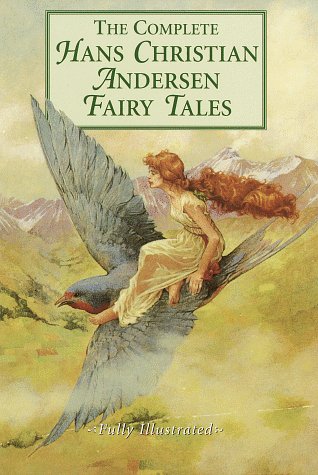
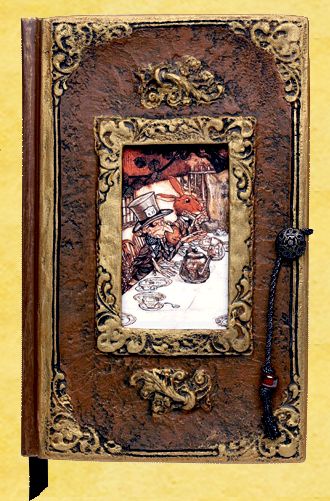
 Available at FigmentsStudio. I will definitely be buying at least one, eventually, despite the high prices.
Available at FigmentsStudio. I will definitely be buying at least one, eventually, despite the high prices.

 Available at FigmentsStudio. I will definitely be buying at least one, eventually, despite the high prices.
Available at FigmentsStudio. I will definitely be buying at least one, eventually, despite the high prices.
 Kay Nielsen, 1886-1957, was a Danish illustrator of fairy tales. I have to admit, before I started blogging I didn't think too much about fairy tale illustrators and only knew the artists of a few of the most famous illustrations of Beauty and the Beast. But since looking for images to accompany posts, I've discovered several artists I really love, one of them being Kay Nielsen.
Kay Nielsen, 1886-1957, was a Danish illustrator of fairy tales. I have to admit, before I started blogging I didn't think too much about fairy tale illustrators and only knew the artists of a few of the most famous illustrations of Beauty and the Beast. But since looking for images to accompany posts, I've discovered several artists I really love, one of them being Kay Nielsen. I totally assumed Kay would be a girl, but you pronounce it "Kigh," and he was a man. I was curious as to what led him to illustrate mainly fairy tale scenes, but it seems he just happened to receive commissions to illustrate fairy tales.
I totally assumed Kay would be a girl, but you pronounce it "Kigh," and he was a man. I was curious as to what led him to illustrate mainly fairy tale scenes, but it seems he just happened to receive commissions to illustrate fairy tales.
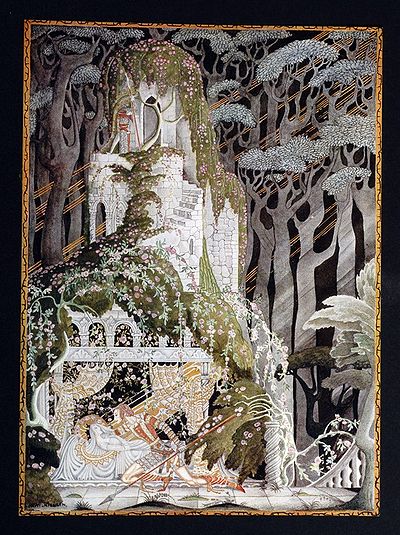 A little Disney tie-in, from the Kay Nielsen Biography:
A little Disney tie-in, from the Kay Nielsen Biography: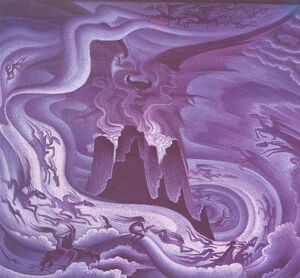
.jpg)


His characters sort through Oedipal difficulties. This isn't too hard a stretch for the abundance of fairy tales with female protagonists, evil mothers and absent fathers. He also interprets Hansel and Gretel as children who were stuck too long in their oral stage and had to move on. Their rushing to eat a house of candy has nothing to do with the fact that the children are starving to death-literally-and only their oral greed (intentional sarcasm here on my part). Beauty and the Beast is a tale of a young woman who transfers her Oedipal attatchments from her father to a mate in a healthy way. Donkeyskin is not a tale about the potential evil of fathers, but a young girl's fantasies that her father will become sexually obsessed with her, and so on.
However, there are many very interesting points he makes as well, so again, it's worth a read. According to his own theories, Bettelheim should have been the most self-actualized person ever, because of all his readings of fairy tales, but he suffered from depression and committed suicide in 1990.

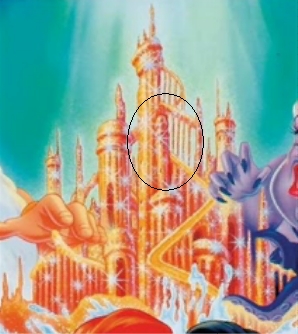 This is it, btw.
This is it, btw.
There was too much fascinating trivia to share here, other than telling you to go read the book yourself. But one thing that I found interesting that relates to issues previously discussed on the blog: some of Disney's harshest criticisms are against the passive female heroines of the earliest Princess movies. Also pretty damning is the racism in Song of the South. Aware of the racial controversy surrounding Song of the South, Disney hired Maurice Rapf to work with writer Dalton Reymond because of his progressive views. Rapf's version of the script would have appeased many a modern fan, as he made the African Americans more independant. However, Reymond and Rapf didn't get along, and Reymond was assigned a new partner. Rapf's positive story changes went out the window.
Rapf was then assigned to Cinderella. He didn't like the idea of Cinderella being passively bossed around all day, either. He suggested a scene in which one day, "they're ordering her around and she throws the stuff back at them. She revolts, so they lock her up in the attic. I don't think anyone took (my idea) very seriously." Ahead of his time.
One more thing-remember how I secretly think Peter Pan is the villain and Captain Hook a victim of circumstances? Well Rapf didn't like Peter Pan either! He says, "I made Peter Pan a villain. He doesn't want anybody to grow up and that's dangerous, the temptation not to grow up. So I had Wendy tell him off." I like this Rapf guy, too bad he had so little influence.
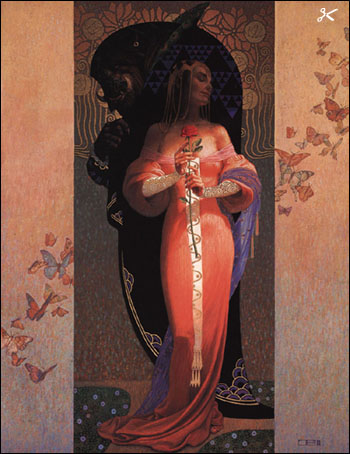 Thomas Blackshear II
Thomas Blackshear II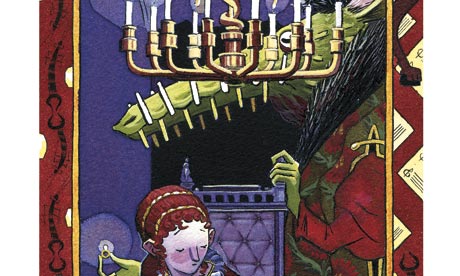
 Walter Crane
Walter CraneThe fairy comes and goes with news of the Prince's mother, and one day tells him of a coming traveler, whose daughter the fairy planned to have break the spell. In order for the terms of the counterspell to be followed correctly, the fairy instructs the beast to threaten the father with his life unless one of his daughters comes in his place. This he does, and the rest is history.
Random-but click here to get non-Disney BatB coloring pages
Part 1 of Muppets in Disney World. A 1990 film not available unless you taped it off tv.
From the comments:
printthelegends
6 months ago
"It was basically made to promote Disney's impending acquisition of the Muppets, which is why Mickey says "welcome to the family," but the deal fell through after Henson's death. "
Responding to a discussion about Disney's "Wish Upon a Star" vs. the Muppets' "Rainbow Connection:"
alttakes
6 months ago 4
"Obviously they're joking about the "philosophy" line [this comes in part 6], but I've always thought that Rainbow Connection was a really profound philosophical song! And much more beautiful than When You Wish Upon a Star, which it even gently criticizes in its lyrics ("Who said that every wish would be heard and answered when wished on the morning star? Somebody thought of that, and someone believed it: and look what it's done so far...")."
I have to admit, as an unabashed Disney fan as I am, I do NOT like the lyrics to Wish Upon a Star, or the fact that that has become the Disney theme song. "Fate is kind/She gives to those who love/The sweet fulfillment of/Their secret longings"...this would be very nice, if it were at all true, but I believe in never lying to children. Sometimes wishes come true, sometimes they don't.
Disneyland Fun Sing-along Songs
Now, this will be of no interest for anyone unless you grew up watching it, or have young kids to show it to...but my siblings and I LOVED this and I totally still watch it before any time I go to Disneyland, and I may or may not work out to it...only 47 more days till I go!!!
1990 must have been a great year for Disney theme parks promotions, because both these movies came out then...
 Edmund Dulac
Edmund Dulac Edmund Dulac
Edmund Dulac Gustav Dore
Gustav Dore Gustav Dore
Gustav Dore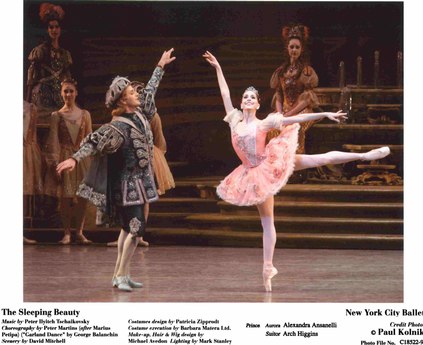 New York City Ballet - Sleeping Beauty - Alexandra Ansanelli as Princess Aurora, Arch Higgins as a SuitorPhoto courtesy of Paul Kolnik
New York City Ballet - Sleeping Beauty - Alexandra Ansanelli as Princess Aurora, Arch Higgins as a SuitorPhoto courtesy of Paul KolnikThe ballet Sleeping Beauty-Music by Pyotr Tchaikovsky-1890 (read more on wikipedia)
Story noteables:
-Mostly based on the Grimm version
-After the kiss, a huge wedding is celebrated with many fairy tale characters, who each get to do a dance
-Names: Sleeping Beauty-Aurora, Prince-Florimund, bad fairy-Carabosse, main good fairy-the Lilac Fairy
-Note: details of plot and choreography will differ from company to company. So the ballet version is more malleable, more like the original oral versions, than the set-in-stone literary versions listed here. Disney movie-Sleeping Beauty-(1957)
Disney movie-Sleeping Beauty-(1957)
Noteables:-Only three good fairies instead of twelve
-The good fairies raise Briar Rose in an attempt to hide her from Maleficent
-This Princess meets and falls in love with the Prince before falling asleep
-A whole battle scene is added between the Prince and Maleficent, who is a dragon for part of the time
-Plot and characters embellished to make a full-length musical
-Soundtrack mostly taken from the Tchaikovsky ballet music

Although, apparantly the Hindu tales were also revised a bit for the sake of religion. In a 1928 book from my library, Washburn Hopkins retells some of these ancient stories. He says, "I have endeavored to tell the tale as I conceive it to have been before it was tampered with, to remove the priestly interpretation and re-interpret the story as it should have descended to us, with the emotional implications (suppressed by the priests) intact." I am not familiar with the other versions of these stories (or if modern scholars agree with Hopkins' claims), but the ones Hopkins tells are retold beautifully. Here I am going to relate excerpts of his tale "Ganges" (also known as Ganga).
"There lived of yore a maid divine, a daughter of the sky,
And all the gods rejoiced in her whenever she passed by.
Like shining water leamed her form, her laugh was like a rill,
She was so happy in her heart she never could be still.
Now sorrow she had never known, and ne'er had heard of woe;
So joyous in the clouds she lived she seldom glanced below;
She had no time for other things, but all her life was play.
She had the clouds to toss about, to sing and greet the day,
And chase the little wandering starts that always got away."
One day Ganges comes to the door of heaven, from where she can look down and see earth. But when she does she is stricken to see the sufferings of the people down below.
"As Ganges looked, the joyousness slow faded from her face,
The dancing light that loved her eyes fled to another place,
And for the first time in her life she felt no longer glad;
She became sorrowful; Ganges was sad." 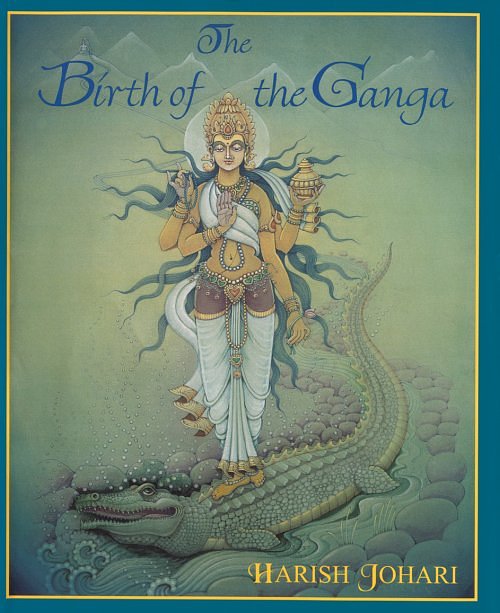
The other gods find Ganges and attempt to distract her.
"Turn thy face from earth, dear, turn thy head and smile.
We from thee have hid the truth but ah, so short a while!
Life is linked with suffering. The truth at last we own,
Which all the gods concealed from thee. We would not make it known"
The gods go on to explain that the earth is in draught and they cannot do anything to help, because Fate has ruled that until a god leaves heaven and gives up their life for the sake of man, the ocean will continue to dry. None of them could imagine giving their lives for the humans, but after considering the matter, Ganges decided she would be the one to make the sacrifice.
 The Ganges River in India
The Ganges River in IndiaGanges, fair Ganges, stood at heaven's high door.
She looked around on all the scenes she was to see no more;
But in her face no sadness showed, her sorrow was at rest,
She felt a wonder of great joy that flooded all her breast.
She gazed upon the earth below, into the distance deep,
There was no fear within her heart to take that deadly leap;
But she loosed her flowing garment and she clasped her hands on high,
And straight before the tearful gods sprang headlong from the sky.
"Thus she leaped, the immortal goddess, thus she left her home above;
Leaped to earth to show to mortals how a heart divine may love.
Touch we e'en her garment, lo! our souls are purified,
And all sins shall be forgiven him that bathes in Ganges' tide."

 The narrator's next goal is loftier: the perfect woman. She will be his Companion, and as she is a product of his imagination, the woman of his dreams. Once again the experiment is successful-but after seeing the beautiful woman, she opens her mouth to reveal a set of vampire teeth. She is not a human woman, but a woman created from the sea. The narrator's dog jumps on her and kills her, leaving not a woman's corpse, but a "bloated, swollen obscenity of a thing long-drowned and dead, risen from slime and to that slime returning." A storm is upon the lighthouse, so fierce the narrator knows he won't survive. He secures his journal entries in a bottle around his dog's neck and waits to die, perhaps to join his Companion in the depths.
The narrator's next goal is loftier: the perfect woman. She will be his Companion, and as she is a product of his imagination, the woman of his dreams. Once again the experiment is successful-but after seeing the beautiful woman, she opens her mouth to reveal a set of vampire teeth. She is not a human woman, but a woman created from the sea. The narrator's dog jumps on her and kills her, leaving not a woman's corpse, but a "bloated, swollen obscenity of a thing long-drowned and dead, risen from slime and to that slime returning." A storm is upon the lighthouse, so fierce the narrator knows he won't survive. He secures his journal entries in a bottle around his dog's neck and waits to die, perhaps to join his Companion in the depths.

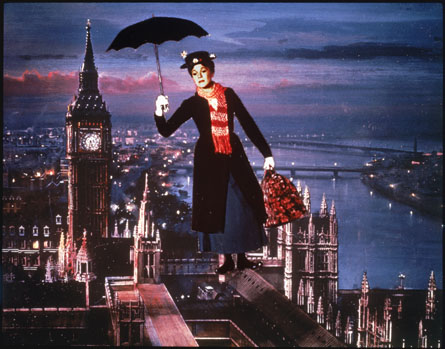 And just for fun...one of the best recut movie trailers is definitely Scary Mary Poppins.
And just for fun...one of the best recut movie trailers is definitely Scary Mary Poppins. I referenced the movie Penelope in this post about the rarity of Animal Bride tales in our culture, and just came across my journal entry for the first time I saw the movie. Many of the issues in the movie are relevant to issues that are prominent in the interpretations and significance of Beauty and the Beast.
I referenced the movie Penelope in this post about the rarity of Animal Bride tales in our culture, and just came across my journal entry for the first time I saw the movie. Many of the issues in the movie are relevant to issues that are prominent in the interpretations and significance of Beauty and the Beast.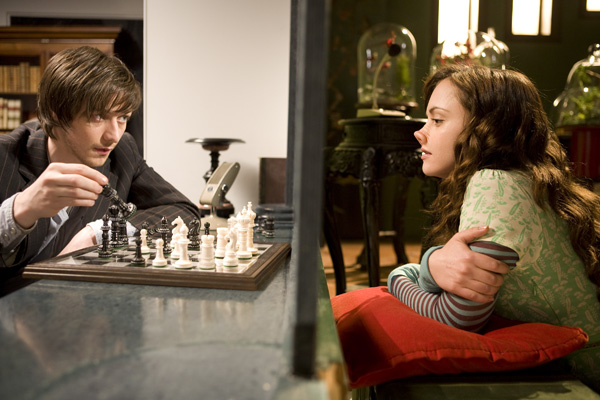 I'm probably analyzing too much. It did at least have a moral, more than most chick flicks. I was kind of hoping she would have to choose b/t marrying the jerk and losing the snout, or marrying James McAvoy and keeping the snout and she'd do that and they'd both live happily ever after. But beauty and the beast tales rarely end that way.
I'm probably analyzing too much. It did at least have a moral, more than most chick flicks. I was kind of hoping she would have to choose b/t marrying the jerk and losing the snout, or marrying James McAvoy and keeping the snout and she'd do that and they'd both live happily ever after. But beauty and the beast tales rarely end that way. I did like the whimsical scenery, the props, and music, and I can't be too harsh on it as it did try to tackle a very important theme and much needed message to our society. It was cute. I did find James McAvoy to be extremely attractive (although that's not supposed to matter...) and I do want Penelope's wardrobe.
I did like the whimsical scenery, the props, and music, and I can't be too harsh on it as it did try to tackle a very important theme and much needed message to our society. It was cute. I did find James McAvoy to be extremely attractive (although that's not supposed to matter...) and I do want Penelope's wardrobe.
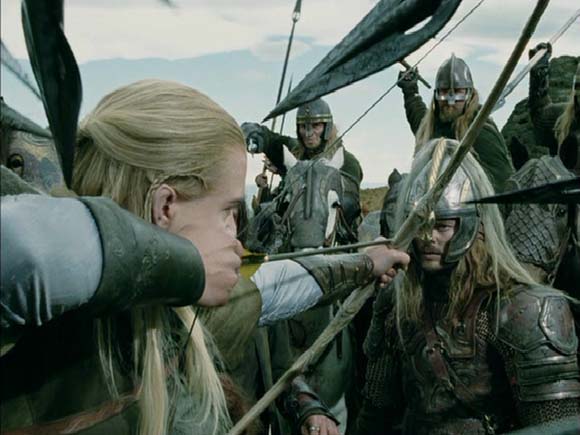
 Hobbits are Tolkein's invention, but aren't too far from a race of simple fairies who live in hills. But the land in which they all live is called Middle Earth, and that once signified the domain inhabited by men and fairies (as opposed to supernatural creatures who live in sky, water, or underground.)
Hobbits are Tolkein's invention, but aren't too far from a race of simple fairies who live in hills. But the land in which they all live is called Middle Earth, and that once signified the domain inhabited by men and fairies (as opposed to supernatural creatures who live in sky, water, or underground.)
 The Tomorrowland section at Disneyland was originally set in 1980 (the park opened in 1955). The whole thing is sort of a retro vision of the future, although of course Disneyland is continuously being revamped. Whenever we imagined the future, it involved huge advances in transportation methods and everyone wearing all silver and traveling in outer space for a weekend outing. We think this optimism almost funny now and wonder where our hover boards are, but our entertainment technology has exploded in a way no one anticipated. Personally, I'm very glad we still wear lots of color.
The Tomorrowland section at Disneyland was originally set in 1980 (the park opened in 1955). The whole thing is sort of a retro vision of the future, although of course Disneyland is continuously being revamped. Whenever we imagined the future, it involved huge advances in transportation methods and everyone wearing all silver and traveling in outer space for a weekend outing. We think this optimism almost funny now and wonder where our hover boards are, but our entertainment technology has exploded in a way no one anticipated. Personally, I'm very glad we still wear lots of color.
 Space Mountain is a great roller coaster. For those who haven't been back in several years, they've been redoing their old roller coasters to be more smooth and have music that goes along with the rides. I love these vintage posters for Disneyland rides and kind of want to wallpaper my room with them:
Space Mountain is a great roller coaster. For those who haven't been back in several years, they've been redoing their old roller coasters to be more smooth and have music that goes along with the rides. I love these vintage posters for Disneyland rides and kind of want to wallpaper my room with them: According to Yesterland, some of the former Tomorrowland rides that did not survive (for obvious reasons) include the Hall of Chemistry, the Hall of Aluminum Fame, and the Bathroom of Tomorrow. One thing that lasted for all of a year but I would seriously love to have gone to was "Fashions and Fabrics Through the Ages."
According to Yesterland, some of the former Tomorrowland rides that did not survive (for obvious reasons) include the Hall of Chemistry, the Hall of Aluminum Fame, and the Bathroom of Tomorrow. One thing that lasted for all of a year but I would seriously love to have gone to was "Fashions and Fabrics Through the Ages."

 "When words fail, music speaks!"- Hans Christian Andersen
"When words fail, music speaks!"- Hans Christian Andersen